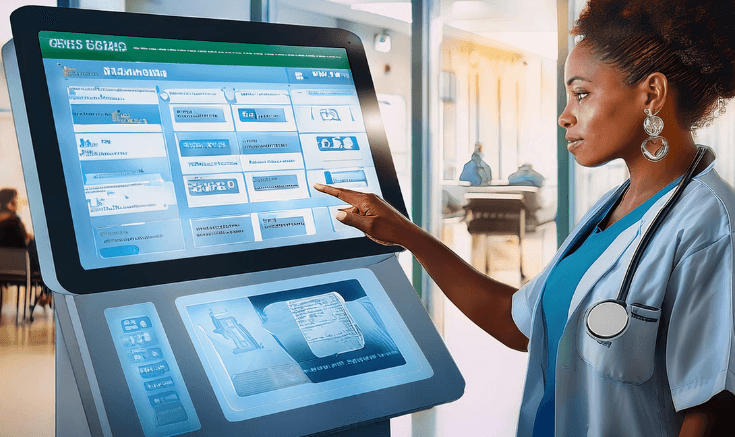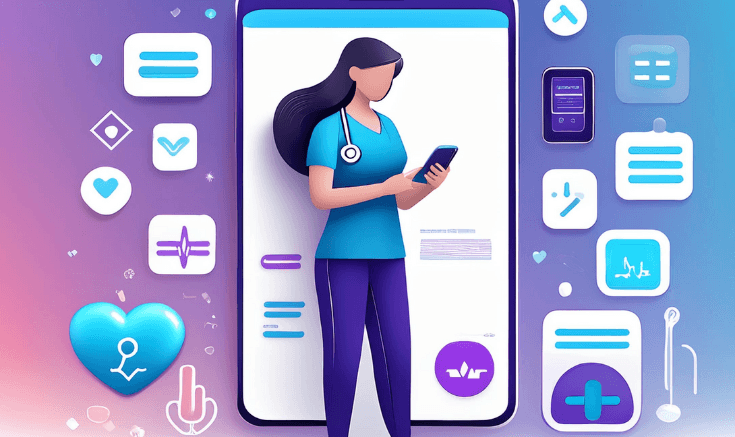

8 examples of robotic process automation in healthcare
DEC. 8, 2024
5 Min Read
Healthcare providers face mounting pressures to deliver efficient services while managing administrative complexity and maintaining high standards of patient care.
Robotic process automation is modifying how healthcare organizations operate, offering practical solutions to streamline workflows, reduce costs, and improve outcomes. This technology is more than a tool—it’s a transformative approach to building a more effective and responsive healthcare system.
Key takeaways
- 1. Robotic process automation in healthcare streamlines administrative and clinical workflows, improving efficiency and reducing operational bottlenecks.
- 2. Automating repetitive tasks minimizes human errors and enhances compliance, ensuring better data accuracy and regulatory adherence.
- 3. RPA reduces costs and increases scalability, helping healthcare organizations adapt to changing demands without overextending resources.
- 4. Automation supports better patient engagement through smoother processes like scheduling, follow-ups, and care plan adherence.
- 5. Implementing RPA requires strategic planning, training, and monitoring to deliver measurable benefits across healthcare operations.
What is robotic process automation in healthcare?

Robotic process automation in healthcare refers to the use of software robots or "bots" to automate repetitive, rule-based tasks traditionally performed by humans. These bots mimic human interactions within digital systems, allowing healthcare providers to streamline workflows, reduce administrative burdens, and improve operational efficiency.
Healthcare systems are under increasing pressure to manage costs, maintain compliance, and deliver high-quality patient care. RPA serves as a transformative solution by automating routine tasks such as data entry, billing, and scheduling. This not only enhances accuracy but also frees up healthcare professionals to focus on patient-centric activities. Unlike traditional automation tools, RPA integrates seamlessly with existing systems without requiring significant infrastructure changes, making it an accessible and cost-effective choice for healthcare organizations.
RPA applications in healthcare extend beyond administrative efficiency. For example, these bots can support clinical processes by automating diagnostics and generating actionable insights from patient data. The result is a more resilient healthcare system that leverages technology to optimize care delivery while managing resources effectively.
"Healthcare systems are under increasing pressure to manage costs, maintain compliance, and deliver high-quality patient care. RPA serves as a transformative solution by automating routine tasks such as data entry, billing, and scheduling."
8 examples of robotic process automation in healthcare
Healthcare organizations face immense challenges balancing operational efficiency with delivering exceptional patient care. Robotic process automation provides a practical, technology-backed solution to many of these challenges by automating repetitive tasks, reducing errors, and freeing up staff to focus on higher-value activities. Whether improving administrative workflows or enhancing patient engagement, robotic process automation in healthcare is redefines how services are delivered.
Implementing RPA allows healthcare providers to optimize both back-end and patient-facing processes. It is not just about automating tasks—it is about creating a more connected, efficient, and responsive healthcare setting.
1. Administrative data entry and management
Healthcare organizations generate and manage vast amounts of data daily. RPA bots can efficiently process and maintain patient records, insurance details, and medical histories without human intervention. These systems integrate with existing databases to extract, update, and validate information accurately.
Manual data entry is prone to errors and delays, which can affect compliance and service delivery. Automating these processes ensures that data remains consistent and readily accessible, even during audits or regulatory reviews. With more reliable data management, healthcare teams can focus their efforts on improving patient outcomes.
2. Appointment scheduling

Managing appointment bookings across multiple channels can overwhelm healthcare providers, especially during peak times. RPA systems streamline this process by automatically scheduling, rescheduling, or canceling appointments based on patient preferences and availability. They can also send reminders and confirmations to reduce missed appointments.
Patients benefit from a smoother scheduling experience, while healthcare facilities can optimize clinic schedules and resource utilization. This level of automation not only improves operational efficiency but also enhances patient satisfaction by reducing wait times and communication gaps.
3. Claims processing and billing

Processing claims and generating bills require meticulous attention to detail to ensure accuracy and compliance with insurance policies. RPA bots can automate data extraction, validation, and submission, reducing the likelihood of human error. They can also identify discrepancies and flag incomplete or incorrect claims for review.
Automated claims processing reduces turnaround times, accelerates reimbursements, and improves financial workflows for healthcare providers. Patients benefit from greater transparency and fewer billing-related disputes, enhancing their overall experience.
4. Patient onboarding and records management
Patient onboarding is often time-intensive, involving document collection, insurance verification, and manual data entry. RPA streamlines this process by automating these tasks, ensuring that patient records are accurate and up-to-date from the start. Bots can cross-verify data against multiple systems, reducing duplications and inconsistencies.
This automation improves the onboarding experience for patients and reduces administrative workloads for staff. With efficient record management, healthcare providers can ensure that patient information is easily accessible when needed, enhancing the quality of care.
5. Compliance and audit procedures

Healthcare organizations operate in a highly regulated ecosystem, requiring meticulous compliance with legal and industry standards. RPA systems assist in creating and maintaining detailed audit trails, ensuring that every process is documented and compliant with regulations.
Automated compliance management reduces the risk of penalties and legal issues while freeing up resources that would otherwise be spent on manual audits. It also provides healthcare administrators with real-time insights into potential risks, allowing proactive issue resolution.
6. Asset tracking and inventory management
Keeping track of medical supplies and equipment is crucial for ensuring uninterrupted patient care. RPA solutions monitor inventory levels, generate alerts for low stock, and track asset usage to prevent shortages or overstocking.
Automating inventory management improves resource allocation and reduces waste. Healthcare facilities benefit from cost savings, while clinicians and patients have consistent access to the tools and supplies they need.
7. Data analytics and diagnostics support
Healthcare providers rely on data-led insights to enhance clinical decisions. RPA facilitates this by aggregating data from disparate systems, creating unified dashboards, and generating actionable reports. These capabilities empower healthcare teams to identify trends, assess risks, and improve patient outcomes.
Automation in diagnostics accelerates the interpretation of test results and helps clinicians identify potential issues earlier. This not only improves the quality of care but also optimizes resource utilization in diagnostics and treatment planning.
8. Post-treatment care and follow-up

Engaging with patients after treatment is critical for ensuring adherence to care plans and monitoring recovery. RPA automates follow-up communications, such as reminders for medication schedules, post-discharge check-ins, and upcoming appointments.
This approach fosters better patient engagement and adherence to prescribed care routines. Healthcare providers can deliver more personalized follow-up experiences, contributing to improved recovery rates and stronger patient relationships.
Robotic process automation in healthcare is redefining the operational framework for providers, helping them meet needs while delivering superior care. Automating essential workflows enhances efficiency, reduces costs, and allows healthcare professionals to concentrate on what matters most—patient outcomes.
"RPA systems assist in creating and maintaining detailed audit trails, ensuring that every process is documented and compliant with regulations."
Implementing RPA in healthcare
Robotic process automation offers significant potential to modify healthcare operations, but its success depends on thoughtful implementation. Introducing RPA requires more than selecting the right technology; it requires a strategic alignment with organizational priorities, staff engagement, and a clear understanding of its long-term impact. For healthcare providers, implementing RPA is an opportunity to address inefficiencies, meet regulatory standards, and improve patient care by focusing on processes where automation can deliver the greatest value.
Effective implementation ensures that automation aligns seamlessly with existing workflows and addresses the unique challenges faced by healthcare organizations. From reducing administrative burdens to enhancing compliance, RPA offers measurable benefits when deployed correctly. A structured approach to RPA implementation allows healthcare providers to maximize its potential and adapt to operational conditions.
Assessing organizational readiness
Understanding the current state of organizational processes is essential before deploying RPA. Identifying repetitive, time-intensive tasks that are prone to human error can help prioritize areas for automation. Detailed workflow mapping ensures that automation targets the right processes and sets clear expectations for outcomes.
Collaborating with key stakeholders across departments helps create alignment and ensures that teams are prepared for the transition. A readiness assessment also includes evaluating IT infrastructure to ensure compatibility with RPA solutions and minimizing risks during deployment.
Choosing the right RPA tools
Selecting the right automation tools involves careful consideration of an organization’s unique needs. Tools must be capable of integrating with existing healthcare management systems and adapting to future scalability requirements. Features such as compliance tracking, user-friendliness, and customization options are critical for ensuring a smooth deployment.
Working closely with IT teams helps assess security risks and ensure adherence to data privacy regulations. The right RPA tools not only streamline workflows but also provide the flexibility to address developing industry requirements.
Ensuring staff engagement and training
Employees are central to the success of RPA initiatives. Clear communication about the benefits of automation fosters trust and mitigates resistance. Training programs tailored to different roles equip staff with the skills they need to interact with automated processes effectively.
Providing opportunities for hands-on experience with RPA technology empowers employees and enhances their confidence in utilizing automation. Engaged staff members are more likely to embrace the technology and identify new opportunities for its application.
Monitoring and scaling the implementation
Continuous monitoring of RPA performance ensures that it delivers the intended results. Tracking key metrics such as time savings, accuracy improvements, and resource optimization provides valuable insights into the effectiveness of the deployment. Addressing any challenges early allows organizations to refine their approach and enhance outcomes.
Scaling RPA implementation gradually helps maintain operational stability while extending automation’s benefits across departments. A phased approach ensures that systems and staff can adapt seamlessly, setting the stage for sustained improvement.
Comprehensive planning and execution are critical to the successful implementation of robotic process automation in healthcare. Thoughtful integration of automation into existing systems delivers immediate operational improvements and establishes a foundation for long-term innovation. Organizations that invest in strategic deployment and staff collaboration position themselves to unlock RPA’s full potential, driving meaningful improvements in both efficiency and patient care.
Benefits of robotic process automation in healthcare
Robotic process automation offers advantages to healthcare organizations by automating routine tasks and improving operational efficiency. These benefits extend across administrative, clinical, and financial processes, letting healthcare providers optimize their workflows and focus more on delivering quality patient care.
- Improved efficiency: Automating repetitive tasks such as data entry, appointment scheduling, and claims processing significantly reduces the time required to complete these activities. This efficiency translates to faster service delivery and reduced operational bottlenecks.
- Error reduction: Manual processes are prone to mistakes that can compromise compliance, financial accuracy, and patient care. RPA enhances accuracy by following predefined rules and eliminating human error.
- Enhanced compliance: Healthcare organizations must adhere to strict regulatory requirements, which can be resource-intensive. RPA ensures that processes are consistently documented and compliant with standards, reducing the risk of penalties and audits.
- Cost savings: Automating labor-intensive processes lowers overhead costs by reducing the need for extensive manual intervention. These savings can be reinvested into patient care or other strategic initiatives.
- Scalability: RPA solutions adapt to fluid organizational needs, making them ideal for handling fluctuations in workload. Automation ensures that healthcare providers can scale their operations without significant increases in staffing or infrastructure costs.
- Better patient experience: RPA streamlines processes like appointment scheduling, patient onboarding, and follow-up communications, resulting in a smoother, more responsive experience for patients. These improvements foster trust and satisfaction.
- Increased staff productivity: Automation reduces administrative burdens on healthcare professionals, allowing them to focus on clinical tasks and patient interactions. This shift enhances workforce satisfaction and productivity.
- Actionable insights: RPA integrates with analytics platforms to deliver real-time data and insights, empowering healthcare providers to make informed decisions about resource allocation, patient care, and operational improvements.
The benefits of robotic process automation in healthcare are both immediate and long-term, allowing providers to deliver more effective, efficient, and patient-centered care. Organizations that embrace automation position themselves to address current challenges while building resilience for future needs.
Business impact of robotic process automation for healthcare
Robotic process automation is reshaping healthcare by driving measurable business outcomes that align with organizational goals. Its implementation creates significant value across multiple dimensions, helping healthcare providers address operational challenges while enhancing strategic capabilities.
One of the most notable impacts of RPA is the reduction of operational costs. Automating repetitive tasks minimizes the reliance on manual labor for administrative functions, allowing healthcare organizations to reallocate resources to patient care and other priority areas. This cost-efficiency is particularly critical for organizations operating within tight budget constraints.
RPA also enhances scalability, permitting healthcare providers to manage increasing workloads without proportionate increases in staffing or infrastructure. This scalability ensures that organizations can adapt to growing patient needs while maintaining service quality. Additionally, automation improves process accuracy, reducing the financial and reputational risks associated with errors in billing, compliance, or patient records.
Healthcare providers benefit from greater agility in responding to regulatory changes and industry trends. Automation ensures that compliance processes are up-to-date and aligned with advancing standards, reducing the burden on administrative staff. RPA fosters innovation and creates opportunities to explore new care models or revenue streams by freeing up time and resources.
Investing in robotic process automation helps healthcare organizations achieve better financial performance, operational efficiency, and patient outcomes. It empowers providers to focus on delivering high-quality care while maintaining a strong, future-ready business foundation.
Robotic process automation isn’t just about efficiency—it’s a pathway to smarter, faster, and more resilient healthcare operations. With the ability to streamline workflows and reduce costs, RPA empowers organizations to focus on what truly matters: delivering better care. At Lumenalta, we specialize in crafting tailored automation solutions that align with your goals, ensuring your organization is ready to flourish.
Let’s build the future of healthcare together.
table-of-contents
- What is robotic process automation in healthcare?
- 8 examples of robotic process automation in healthcare
- 1. Administrative data entry and management
- 2. Appointment scheduling
- 3. Claims processing and billing
- 4. Patient onboarding and records management
- 5. Compliance and audit procedures
- 6. Asset tracking and inventory management
- 7. Data analytics and diagnostics support
- 8. Post-treatment care and follow-up
- Implementing RPA in healthcare
- Benefits of robotic process automation in healthcare
- Business impact of robotic process automation for healthcare
- Common questions about robotic process automation in healthcare
Common questions about robotic process automation in healthcare
What is robotic process automation used for in healthcare?
How does RPA improve healthcare workflows?
Can RPA be integrated with existing healthcare systems?
What challenges can RPA help address in healthcare?
How does RPA impact patient care?
Want to learn how robotic process automation can bring more transparency and trust to your operations?





